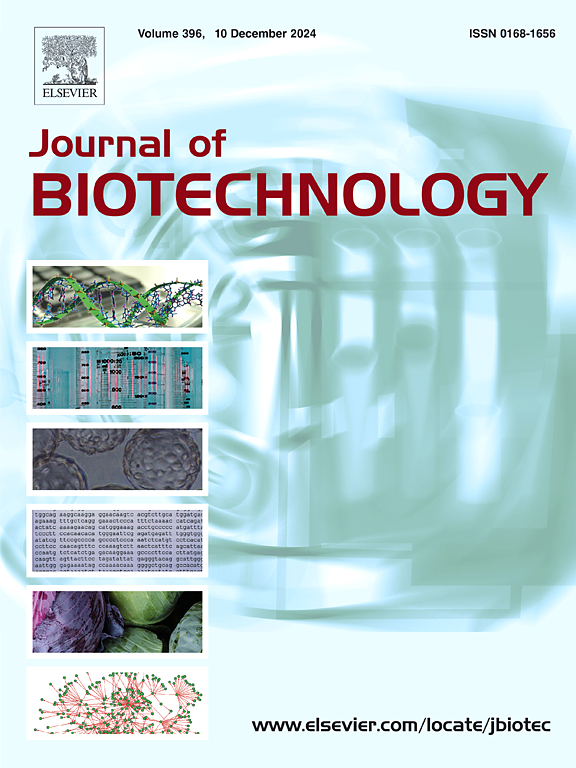Impact of liquid and solid-state cultures on hemoglobin production and oxidative state in Saccharomyces cerevisiae
IF 4.1
2区 生物学
Q2 BIOTECHNOLOGY & APPLIED MICROBIOLOGY
引用次数: 0
Abstract
Recombinant human hemoglobin gained attention due to its potential use as a blood-free oxygen carrier substitute. To enhance human hemoglobin production in Saccharomyces cerevisiae, various genetic engineering strategies have been employed, including: increasing intracellular heme levels, minimizing heme and protein degradation pathways, and co-expressing the α-hemoglobin stabilizing protein (AHSP). Solid-state culture (SSC) may enhance hemoglobin production by increasing heme biosynthesis, as it relates to intracellular oxygen availability. A comparative analysis of heme and hemoglobin production was conducted between liquid culture (LC) and SSC using the S. cerevisiae AHSP strain. While both systems exhibited comparable heme and hemoglobin yields per cell, a significant 18 % increase in biomass was observed in SSC. The expression of the aerobic master gene HAP1 remained consistent between both systems, however, CYC1 (regulated by HAP1) was two-fold overexpressed in SSC, indicating higher oxygen transference and possibly more efficient electron transport. Several antioxidant genes were downregulated in the SSC, suggesting that LC may be more susceptible to electron leakage during oxidative phosphorylation, potentially due to the lower expression of CYC1. It is proposed that high expression of antioxidant genes in LC inhibits biomass production due to the metabolic burden of maintaining redox homeostasis. These differences between LC and SSC may explain the suitability of SSC as a platform for recombinant protein production.
液体和固体培养物对酿酒酵母血红蛋白生成和氧化状态的影响。
重组人血红蛋白因其作为血氧载体替代品的潜在用途而受到关注。为了提高酿酒酵母菌的人血红蛋白产量,各种基因工程策略被采用,包括:增加细胞内血红素水平,最小化血红素和蛋白质降解途径,以及共同表达α-血红蛋白稳定蛋白(AHSP)。固态培养(SSC)可以通过增加血红素的生物合成来提高血红蛋白的产生,因为它与细胞内氧的可用性有关。对酿酒葡萄球菌AHSP菌株进行了液体培养(LC)和SSC培养(SSC)血红素和血红蛋白产量的比较分析。虽然两种系统的每细胞血红素和血红蛋白产量相当,但SSC的生物量显著增加了18%。有氧主基因HAP1的表达在两种系统中保持一致,然而,CYC1(由HAP1调节)在SSC中过表达两倍,表明更高的氧转移和可能更有效的电子传递。几个抗氧化基因在SSC中下调,这表明LC可能在氧化磷酸化过程中更容易发生电子泄漏,可能是由于CYC1的表达较低。研究人员提出,LC中抗氧化基因的高表达可能是由于维持氧化还原稳态的代谢负担而抑制了生物量的产生。LC和SSC之间的这些差异可能解释了SSC作为重组蛋白生产平台的适用性。
本文章由计算机程序翻译,如有差异,请以英文原文为准。
求助全文
约1分钟内获得全文
求助全文
来源期刊

Journal of biotechnology
工程技术-生物工程与应用微生物
CiteScore
8.90
自引率
2.40%
发文量
190
审稿时长
45 days
期刊介绍:
The Journal of Biotechnology has an open access mirror journal, the Journal of Biotechnology: X, sharing the same aims and scope, editorial team, submission system and rigorous peer review.
The Journal provides a medium for the rapid publication of both full-length articles and short communications on novel and innovative aspects of biotechnology. The Journal will accept papers ranging from genetic or molecular biological positions to those covering biochemical, chemical or bioprocess engineering aspects as well as computer application of new software concepts, provided that in each case the material is directly relevant to biotechnological systems. Papers presenting information of a multidisciplinary nature that would not be suitable for publication in a journal devoted to a single discipline, are particularly welcome.
 求助内容:
求助内容: 应助结果提醒方式:
应助结果提醒方式:


